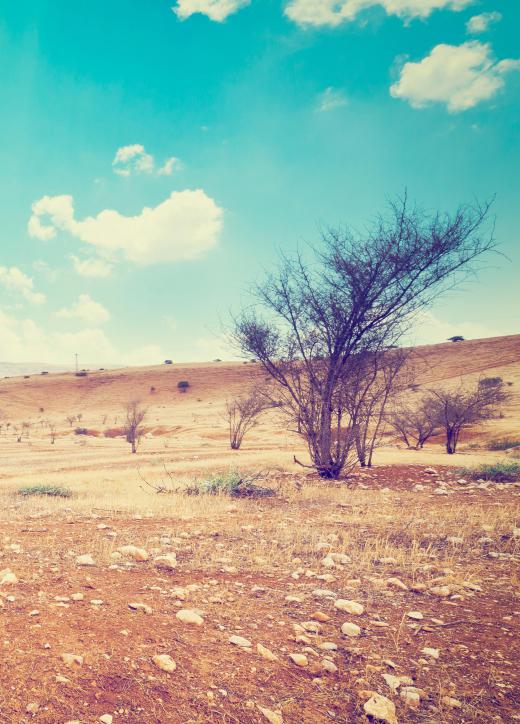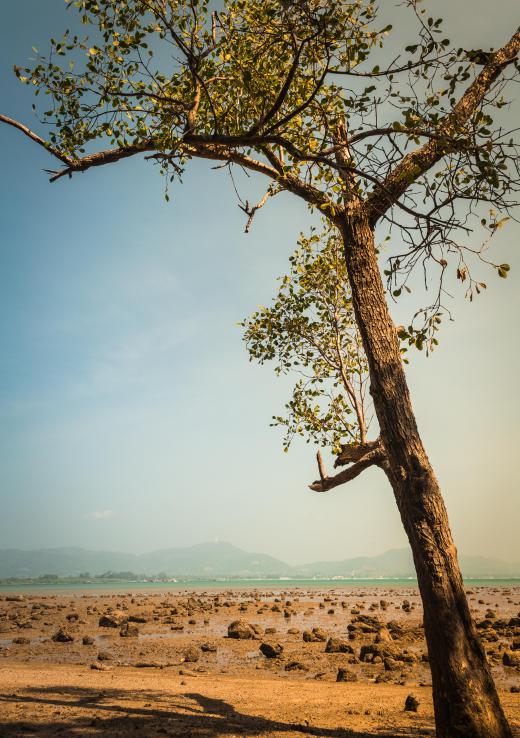What is Vegetation?
 Mary McMahon
Mary McMahon
Vegetation is plant life, which can vary from unexplored tropical forests to the cultivated plants of a farm or garden. Plant life is a topic of interest among many scientists and researchers because it plays an important role in the interconnected systems of life on Earth. Vegetation provides food, shelter, habitat, and a number of other services to the natural world, whether it is clinging to sandy dunes in the desert or taking over abandoned properties in a settled temperate zone. People who study plant life on Earth include botanists, general biologists, ecologists, agronomists, foresters, and oceanographers.
Several scientific organizations have classified the world's vegetation to create a series of biomes, zones on Earth with shared characteristics which can be defined by the plant life they contain. There are a number of classification systems in use, depending on where in the world one is, which describe biomes in terms such as the types of plants found there, the soil conditions, the climate, and the historical use of the land. Some examples of vegetation biomes include tropical plants, high alpine plants, and desert plants.

One important function of vegetation is soil stabilization and enrichment. Having plants around improves the soil, with the plants trapping nutrients and water to make the soil better. In addition, the roots and other structures of the plant work to hold down the topsoil so that it is not lost. Vegetation also plays a role in flood control, as plants can help to create buffer zones which keep flood waters at bay, especially in marshlands.

For animals, vegetation provides ample habitat along with food. Animals live in plants or use plant materials to construct homes, and many plants are edible, for at least some species. Other animals in turn prey on animals which feed on vegetation. Gardeners, whether they are growing food or ornamental plants, utilize plant life in a variety of creative ways, depending on the climate or zone they grow in.

In areas where vegetation is lacking or scrubby, it can contribute to environmental problems. Loss of vegetation contributes to loss of topsoil, making the soil less useful, and it can also cause the area to grow warmer because the plants are not acting as a heat sink to keep temperatures more moderate. Lack of plants also means lack of food, a serious problem in regions of the world which are undergoing desertification and experiencing food insecurity as a result.
AS FEATURED ON:
AS FEATURED ON:















Discussion Comments
Vegetation management is a hot topic, especially with deforestation happening in the Brazilian Amazon. More than 10% of the forests in that region have been deforested either through natural fires or industrial activities.
Some people argue that the forests are replaced with newer forests, but the reality is that the newer forests are not as tall or dense as the forests they replaced. They are lower-grade, and thus more susceptible to fires. Thus the vicious cycle continues, especially in seasons of drought.
With climate change such an important concern, I think we need to focus more on saving our existing natural resources instead of kidding ourselves that we are renewing what we strip away.
Certain types of plant vegetation, usually misclassified as “weeds,” help improve the soil quality. One such example is clover—yes, the stuff that’s supposed to make you lucky.
Most people think of these plants as weeds that need to be killed or uprooted. Many professional lawn services certainly treat them as such and try to kill them. In fact, however, clover is considered to be good for the soil.
Clover is a legume and what it does is add nitrogen to the soil. You’ve heard that nitrogen is good for your soil (it’s in fertilizers), so why would you kill a source of nitrogen that you could get for free? The next time that you see clover in your lawn, thank your lucky stars that it’s there and don’t kill it. Your lawn will thank you too, with more lush grass.
Post your comments